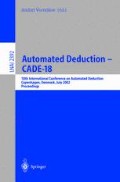Abstract
The Ωmega proof development system [2] is the core of several related and well integrated research projects of the Ωmega research group.
Access this chapter
Tax calculation will be finalised at checkout
Purchases are for personal use only
Preview
Unable to display preview. Download preview PDF.
References
S. Allen, R. Constable, R. Eaton, C. Kreitz, and L. Lorigo. The Nuprl open logical environment. In Proc. of CADE-17, LNAI 1831. Springer, 2000.
C. Benzmüller et al. Ωmega: Towards a mathematical assistant. In Proc. of CADE-14, LNAI 1249. Springer, 1997.
C. Benzmüller and V. Sorge. Ω-Ants-An open Approach at Combining Interactive and Automated Theorem Proving. In Proc. of Calculemus-2000. AK Peters, 2001.
W.W. Bledsoe. Challenge problems in elementary analysis. Journal of Automated Reasoning, 6:341–359, 1990.
A. Bundy. The Use of Explicit Plans to Guide Inductive Proofs. In Proc. of CADE-9, LNCS 310. Springer, 1988.
A. Bundy, F. van Harmelen, J. Hesketh, and A. Smaill. Experiments with proof plans for induction. Journal of Automated Reasoning, 7:303–324, 1991. Earlier version available from Edinburgh as DAI Research Paper No 413.
L. Cheikhrouhou and V. Sorge. PDS — A Three-Dimensional Data Structure for Proof Plans. In Proc. of ACIDCA’2000, 2000.
A. Church. A Formulation of the Simple Theory of Types. The Journal of Symbolic Logic, 5:56–68, 1940.
S. Owre et al. PVS: Combining specification, proof checking and model checking. In Proc. of CAV-96, LNCS 1102. Springer, 1996.
A. Fiedler. P.rex: An interactive proof explainer. In Proc. of IJCAR 2001, LNAI 2083. Springer, 2001.
M. Kohlhase and J. Zimmer. System description: The MathWeb Software Bus for Distributed Mathmatical Reasoning. In Proc. of CADE-18, LNAI. Springer, 2002.
A. Franke and M. Kohlhase. System description: MBase, an open mathematical knowledge base. In Proc. of CADE-17, LNAI 1831. Springer, 2000.
M. Gordon and T. Melham. Introduction to HOL-A theorem proving environment for higher order logic. Cambridge University Press, 1993.
W. McCune. Otter 3.0 reference manual and guide. Technical Report ANL-94-6, Argonne National Laboratory, Argonne, Illinois 60439, USA, 1994.
A. Meier. TRAMP: Transformation of Machine-Found Proofs into Natural Deduction Proofs at the Assertion Level. In Proc. of CADE-17, LNAI 1831. Springer, 2000.
A. Meier, M. Pollet, and V. Sorge. Comparing Approaches to Explore the Domain of Residue Classes. Journal of Symbolic Computations, 2002. forthcoming.
E. Melis and A. Meier. Proof Planning with Multiple Strategies. In Proc. of CL-2000, LNAI 1861. Springer, 2000.
E. Melis and J. Siekmann. Knowledge-Based Proof Planning. Artificial Intelligence, 115(1):65–105, 1999.
E. Melis, J. Zimmer, and T. Müller. Integrating constraint solving into proof planning. In Proc. of FroCoS 2000, LNAI 1794. Springer, 2000.
J.D.C Richardson, A. Smaill, and I.M. Green. System description: Proof planning in higher-order logic with λ-CLAM. In Proc. of CADE-15, LNAI 1421, Springer, 1998.
J. Siekmann et al. \( \mathcal{L}\mathcal{O}\mathcal{U}\mathcal{I}{\text{: }}\mathcal{L}{\text{ovely}} \) Ωmega \( \mathcal{U}{\text{ser }}\mathcal{I}{\text{nterface}} \). Formal Aspects of Computing, 11:326–342, 1999.
V. Sorge. Non-Trivial Computations in Proof Planning. In Proc. of FroCoS 2000, LNAI 1794. Springer, 2000.
Coq Development Team. The Coq Proof Assistant Reference Manual. INRIA. see http://coq.inria.fr/doc/main.html.
Author information
Authors and Affiliations
Editor information
Editors and Affiliations
Rights and permissions
Copyright information
© 2002 Springer-Verlag Berlin Heidelberg
About this paper
Cite this paper
Siekmann, J. et al. (2002). Proof Development with Ωmega . In: Voronkov, A. (eds) Automated Deduction—CADE-18. CADE 2002. Lecture Notes in Computer Science(), vol 2392. Springer, Berlin, Heidelberg. https://doi.org/10.1007/3-540-45620-1_12
Download citation
DOI: https://doi.org/10.1007/3-540-45620-1_12
Published:
Publisher Name: Springer, Berlin, Heidelberg
Print ISBN: 978-3-540-43931-8
Online ISBN: 978-3-540-45620-9
eBook Packages: Springer Book Archive

